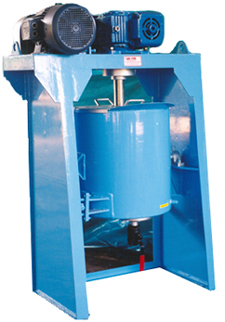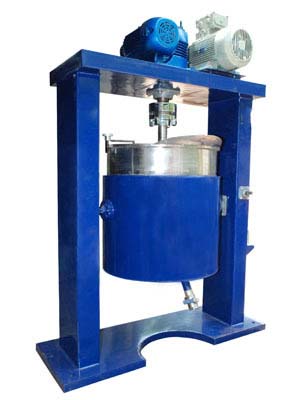

Attritor is used for producing fine & homogeneous dispersons quickly & repeatedly under controlled conditions. Used for the manufacture of ceramics , inks, paints,coatings, metal oxides, ferrites, chocolates, chemicals & pharmaceuticals. The Attritor is often referred to as a agitated ball mill. The material to be ground is charged into a vertical tank filled with grinding media. Both the material and grinding media are then agitated by a shaft with arms causing the media to exert shearing & impact forces on the material. This action produces an extremely fine material measured in microns. No pre mixing is required. All attritors are provided with cooling jackets. Recirculating facility is available as optional.
ADVANTAGES OF USING A BATCH ATTRITOR
- Ten times faster than ball mills
- Simple to operate
- Energy efficient
- No premixing required
- Minimum maintenance required
- Rugged construction
- Compact design
- No special foundation necessary
ADVANTAGE OF LAB ATTRITOR
Fast And Efficient Grinding, Scale-Up Capability, Numerous Options, No Premixing, Flexibility, Easy Operation, Repeatability, Low Maintenance;
LAB ATTRITORS:
APPLICATIONS FOR ATTRITORS
- Paints, toners, inks
- Ceramics
- Agricultural flowables
- Food products
- Chocolate, confectionery
- Paper coatings, calcium carbonate, clay
- Chemicals
- Ferrites
- Metal oxides
- Minerals, ores, coal
- Sulphur dispersions
OPERATING PRINCIPAL:
- Machine Operates According To The Principle Of An Agitator Bead Mill. The Vertically Arranged Special Agitator Is Equipped With Agitator Pegs.
- Ideal Flow Conditions Are Reached Through The Combination Of Optimally Arranged Agitator Pegs And The Hemispherical Grinding Chamber Floor.
- Circulation Grinding Guarantees An Exact Reproducibility And High Product Homogeneity|
WORKING PRINCIPLE OF ATTRITOR:
The Attritor Is Often Referred To Generically As A “Stirred Ball Mill.” The Operation Of An Attritor Is Simple And Effective. The Material To Be Ground Is Placed In A Stationary Tank With The Grinding Media. Carbon Steel, Stainless Steel, Chrome Steel, Tungsten Carbide And Ceramic Balls Are Commonly Used Media. The Material And Media Are Then Agitated By A Shaft With Arms, Rotating At High Speed. This Causes The Media To Exert Both Shearing And Impact Forces On The Material. The Final Result Of This Remarkably Efficient Process Is An Extremely Fine Material, Measured In Microns Or Fractions Of Microns, Distributed On A Very Narrow Curve. The Laboratory Attritor Works Up To Ten Times Faster Than The Conventional Ball, Pebble Or Jar Mill. Its Compact, Vertical Profile Requires Minimal Space. No Premixing Is Necessary. Adding Ingredients (Or Taking Samples) Can Be Done At Any Time During The Grinding.
CONSTRUCTION:
The Vessel Is Made From Thick S.S.304. Material To Withstand Heavy Loads And Is Provided With A Top Cover In Two Halves Which Can Be Locked On To The Main Vessel By Means Of Eye Bolts. A Jacket In M.S. Construction For Heating And Cooling Is Provided Complete With Inlet Outlet And Drain Fittings. Cooled Chamber And Product Pipeline. A Specially Designed Ball Valve With Strainer Is Provided At The Bottom Of The Vessel For Quick Discharge Of The Material. The Complete Vessel Is Mounted On Steel Shaft Perfectly Balanced And Housed On The Frame Structure. The Entire Vessel Can Be Tilted By Means Of A Mechanical Device To Facilitate Cleaning Operations. Residue-Free Discharge And Easy Cleaning Due To Dish Bottom Chamber. The Main Shaft Is Connected To The Output End Of The Gear Box Assembly By Means Of C.I./M.S. Rigid Flange Type Coupling. The Shaft Is Carefully Machined And Fitted With Specially Designed Adjustable Attrition Arms Which Rotate At 120 RPM. The Unit Is Painted With 2 Coats Of Metal Primer And 2 Coats Of Synthetic Enamel Paint.
ELECTRICAL:
All Electrical Are 3 Phases, 50 Cycles, and 400 V.
PANEL: The Machine Is Complete With An Electrical Panel Consisting Of Ammeter, Voltmeter And “ON/OFF” Switches.
DRIVE: The Drive Unit Is Enclosed In Steel Cabinets Supported And Stiffened By Structural.
USEFUL TIPS
A useful and simple equation describing the grinding momentum is M x V (mass x velocity), which enables us to see how the Attritor fits into the family of mills. For example, ball mills use large media, normally 1/2″ or larger, and run at a low (10-50) rpm. The other mills, such as sand, bead, and horizontal, use smaller media (from 1/64″ to 1/8″), but run at a very high rpm (roughly 800-1200). High-speed dispersers with no media run even faster (1200-1800) rpm, with tip speeds of 5000-6000 fpm. The Attritor falls mid-range between these, using 1/8″ to 3/8″ media, agitating at moderate speeds from 60 rpm in the largest production size units, to 300 rpm for the laboratory size units (with tip speeds of 600-1000 fpm). The most important concept in the Attritor is that the power input is used directly for agitating the media to achieve grinding and is not used for rotating or vibrating a large, heavy tank in addition to the media.
Description |
SFA 5 |
SFA 25 |
SFA 50 |
SFA 100 |
SFA200 |
SFA 300 |
SFA 500 |
SFA 1000 |
SHELL THICKNESS |
6 mm |
6 mm |
6 mm |
6 mm |
6 mm |
6 mm |
6 mm |
6 mm |
Tank Vol LTS |
5 |
25 |
50 |
100 |
200 |
300 |
500 |
1000 |
Slurry Vol LTS |
2.4 |
12 |
24 |
50 |
100 |
145 |
225 |
450 |
Media Kgs |
5 |
24 |
45 |
90 |
180 |
275 |
450 |
900 |
Motor HP |
1 |
3 |
5 |
7.5 |
15 |
20 |
25 |
50 |
Agitator RPM |
145 |
130 |
130 |
125 |
110 |
110 |
105 |
105 |
Fluid Coupling |
ABSENT |
ABSENT |
ABSENT |
ABSENT |
PRESENT |
PRESENT |
PRESENT |
PRESENT |
Floor Space |
38 X 80 |
41 X 86 |
51 x 103 |
60 x 136 |
76 x 159 |
83 x 170 |
120 x 210 |
140 x 235 |
W x D |
cms |
cms |
cms |
cms |
cms |
cms |
cms |
cms |
**Features variable speed drive motor |
||||||||
***Varies according to motor HP. |
||||||||
